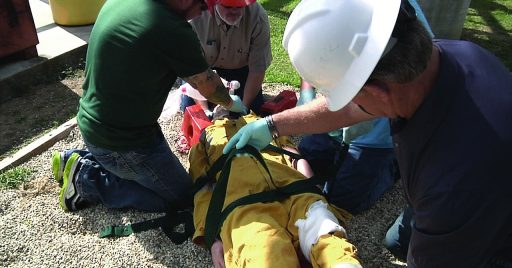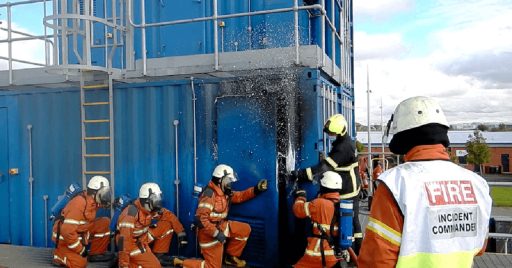Offshore emergency response is an integral part of workplace safety for the upstream oil and gas industry. The historical rate of fatal accidents is so high that it necessitates well-planned EER procedures. It took an accident such as Piper Alpha in 1988 to wake up the oil rig industry and initiate an inquiry into the current systems.
EER stands for evacuation, escape, and rescue and is the procedure in which people are taken to a safe ground during an accident such as a fire and explosion. The importance of EER is more critical in offshore drilling sites due to the surrounding water that poses additional safety risks.
EER is a complex procedure that requires extensive personnel training regarding layout of the platform and the availability of escape routes and vessels. Proper emergency drills are critical contributors to the success of EER, which played a crucial role in saving 115 lives during the Deepwater Horizon explosion in 2010.
However, offshore emergency response can turn into a Halloween nightmare for an HSE manager if the planning or execution is faced with an even small obstacle. But there is hope if modern technology such as AI is considered!
This article will provide an overview of offshore emergency response so managers and HSE professionals have enough knowledge to make informed decisions.
Regulations and Best Practices for offshore emergency response
There are many parties involved in a successful EER and offshore emergency response as well as detailed procedures and variety of equipment that together save lives during accidents on offshore drilling rigs.
The Health and Safety at Work Place regulations are often passed by national organizations such as OSHA, HSE UK, BSEE and MCA but international associations such as IADC or national institutes such as API also define best practices due to the fact that they collect and develop data within the industry which can reveal critical needs at the time of offshore emergency responses such as the followings:
- An Emergency Control Center (ECC) should be designated in each site with a well-practiced Emergency Response Plan (ERP) that is clear and functional.
- Risk assessment is an essential component of the EER plan that should be in precise details down to exposure times at different temperatures for persons in water.
- Appropriate arrangements should be made to make sure alarm is raised at the early stage of incident that may require an emergency response. Artificial intelligence can be extremely helpful in here since it has access to all CCTV cameras throughout the site and is able to detect even the smallest hazards and sound the alarms!
- All necessary communication equipment must be available between people, vessels, shore, emergency services and medical support team.
- At least one person should be authorized to initiate an offshore emergency response.
- All necessary arrangements for evacuation should be in place.
- All necessary means of escape should be available in case arrangements for evacuation fail.
- All necessary arrangements for recovery and rescue of people should be made.
- All people must be recovered and rescued to a place of safety from any risk to their health such as immersion in the sea, smoke, fire, explosion, heat, toxic gases and particulates.
- A well-announced muster area should be designated where personnel can assemble and be accounted for.
- An up-to-date list of all personnel allocated to a muster area must be available.
- A well-exercised evacuation procedure should be in place so personnel can leave safely without directly entering the sea and be transferred to safety of an onshore location or offshore vessel.
- Primary evacuation vessels such as Helicopter should be provided for protection against hazards and quickly moving away from the site.
- Secondary means of evacuation should also be available for safety backup.

- There should be sufficient number of competent medical personnel to attend to ill or injured workers based on first aid need assessment.
- Tracking devices in sufficient number are critical to search for missing persons in EER operations.
- Enough number of compatible personal protective equipment (PPE) should be available for all personnel. Artificial intelligence is perfectly capable of detecting PPE violations in offshore emergency response and notifying HSE professionals!
- There should be sufficient lifesaving appliances such as life jackets, immersion suits, life rafts, life buoys and survival craft in visible colors to make them conspicuous when in use.
- lifesaving equipment should come with features that take into account weather conditions and the time it takes to recover a person from the sea.
- lifesaving appliances should have proper certifications such as SOLAS approved auto-inflating lifejackets that have spray hoods, crotch or thigh straps. They should also provide adequate airway protection when worn over an immersion suit.
- Lifeboats Release and Recovery Systems (LRRS) should also consider the weight of people so they can arrive to safe grounds without the risk of sinking. Machine learning capability with data analytics can easily do the math in the planning process according to the personnel data so each lifeboat is only filled with right number and weight of people!

Conclusion
Offshore emergency response has been saving lives in the oil and gas industry due to the constant changes that were made in regulations and best practices after each terrible accident in the past 3 decades. The standards start from planning the EER (evacuation, escape and rescue) procedure and providing all necessary means for all people on board. This includes presence of well trained HSE professionals and medical support team as well as full feature lifesaving appliances, escape vessels, compatible PPE and communication equipment.
But with rapid advancement in technology, there is a much more intelligent tool available now that can take over the whole process and streamline it to the highest safety. AI powered HSE management system is the optimum solution to eliminate mistakes and fatalities on drilling rigs and optimize offshore emergency response.
Intelligent HSE is the answer for a modern EER that can save every life on an offshore site while minimizing the time, effort and cost needed. It is the best tool every manager dreams to have!